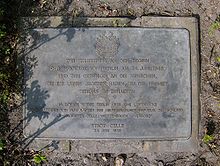Wietzenbruch
|
Wietzenbruch
City of Celle
Coordinates: 52 ° 35 ′ 54 ″ N , 10 ° 0 ′ 31 ″ E
|
|
|---|---|
| Height : | 38 m above sea level NN |
| Area : | 10.67 km² |
| Residents : | 4875 (Jan. 1, 2011) |
| Population density : | 457 inhabitants / km² |
| Postal code : | 29225 |
| Area code : | 05141 |
Wietzenbruch is a district in the southwest of the Lower Saxony town of Celle , which was named after the quarry forest through which the Wietze river ran . Originally the center of Wietzenbruch was a smaller estate belonging to the von Anderten family.
Wietzenbruch has belonged entirely to the city of Celle since 1973 (previously partially) and has become a popular new development area.
history
The Wietzenbruch district of Celle is one of the younger settlements in the district of Celle . It owes its creation to the division of the Wietzenbruch , a large forest and moor-like area, which extends beyond the eastern district of Celle to the edge of the district of Heidekreis , in the years 1815-1825.
In the 1920s , the Wietzenbruch built the first German high-speed line for test runs and record runs of railway locomotives. In allusion to the long construction period (1913–1938), the route is popularly known as the "rabbit railway". Today it is part of the Hanover – Hamburg railway line .
The Celle Army Airfield (Immelmann barracks) in Celle-Wietzenbruch became known at the end of the 1940s as one of the starting points for supply aircraft for the Berlin Airlift . The airlift memorial at the entrance to the town , initiated in 1985 by the then Celle town councilor Karl Duffner and inaugurated in 1988, commemorates this event . Until 2013, the air base was the location of the Army Aviation Training Center C as well as the Army Aviation Liaison and Reconnaissance Squadron 100.
Andertenhausen
Andertenhausen is an example of new estates that were built far outside the town of Celle at the beginning of the 19th century . The Major General Heinrich von Anderten in Celle had had the misfortune three times to lose the wife at the birth of a child, the last on May 31, 1830, because of her beauty by Heinrich Heine admired "beautiful woman of Celle," Caroline du Plat (1799 –1830), daughter of Colonel Georg Carl August du Plat . The bitter widower from the Hanoverian patrician family von Anderten decided to create an estate for his descendants out in the solitude, which was to be named "Andertenhausen" after his family. Gradually, he had acquired 160 acres of land in the Neuenhäuser part of the Wietzenbruch and built a house, stables and barns there in 1838 and created 53 acres of fields, 47 acres of meadows and 43 acres of wood from the wilderness, partly with his own hands. He paid great attention to the decoration of the house, the park and the gardens. Von Anderten lived and ran the estate until his death in 1851. Although his father made it a priority that Andertenhausen should remain family property, his son William von Anderten, Rittmeister in Hildesheim, sold the estate. (Location Gut Andertenhäusen)
politics
Local mayor is Gerda Kohnert ( SPD ).
literature
- Uwe Förster: Airlift commission - The sky over Berlin 1948-1949 . German Technikmuseum Berlin and Landesbildstelle Berlin. Nicolai, Berlin 1998, p. 158 ff., ISBN 978-3-87584-692-8 .
- Wolfgang J. Huschke: The Candy Bombers: The Berlin Airlift 1948/49 / The Technical Conditions and Their Successful Transformation . 2nd edition, Berliner Wissenschafts-Verlag, Berlin 2008, p. 172, ISBN 3-932482-19-0 .
Web links
Individual evidence
- ↑ In detail: Blazek, Matthias: Holzung, Mast und Jagd im Wietzenbruch / Iron production in the Middle Ages of importance - Inhospitable area used by Celle residents in community with Westerceller residents as pasture for centuries, Sachsenspiegel 38, Cellesche Zeitung of September 20, 2003.
- ↑ In detail: Blazek, Matthias: The first houses in Wietzenbruch were built from 1838/1869 together with Andertenhäusen and incorporated - in the course of the general division of the Wietzenbruch / The Fuhse Canal, built 1766–1769, drained the swampy lowlands, Sachsenspiegel 6, Cellesche Zeitung of February 9th 2002.
- ↑ In detail: Blazek, Matthias: "The record attempts of 1928 - The rocket-powered rail car on the Langenhagen – Celle railway line", in: Heimatland , ed. from the Heimatbund Lower Saxony 2008.
- ↑ Read in detail about the history of the former Reichsbahnlinie: Blazek, Matthias; Evers, Wolfgang: Construction of the Reichsbahn line Celle-Langenhagen. "Hasenbahn" was double-tracked 35 years ago / Most of the line runs dead straight - First World War put an end to the construction work, Sachsenspiegel 21 and 22, Cellesche Zeitung from May 29th and June 5th 1999.
- ^ Möller, Reinhard WLE: Streets in Celle, Celle 1995, p. 202.
- ↑ Cellesche-Zeitung.de .

